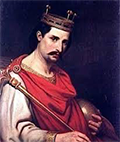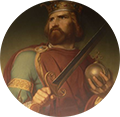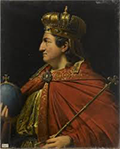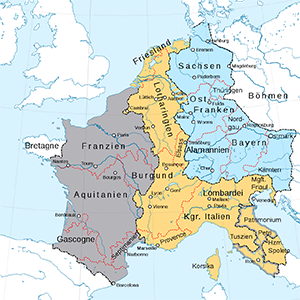The Carolingians
Part 1: Beginnings and Division The namesake of the Carolingian dynasty was Charles Martel, the 8th-Century Frankish king most famous for defeating a large Muslim army at the Battle of Tours. His son, Pepin III, was also King of the Franks, as was his son, Charles. This was the famous Charlemagne, whose skills in the diplomatic and military realms created an empire the lies of which hadn't been seen in Europe in a few centuries. When Charlemagne died, in 814, he had one surviving son, Louis, who inherited the entire kingdom. He became known as Louis the Pious because of his preference for religion and study and not military prowess.
Louis had three sons, Charles, Lothair, and Louis. In 817, King Louis had divided his kingdom among his three sons, so that they should share in the rule. however, the king had named his oldest son, Lothair, as co-emperor and overlord of his brothers. When Louis died in 840, Lothair claimed the entirety of the three brothers' lands as his own. Charles and Louis declared war on Lothair, and a civil war ensued. Three years later, that war ended with the Treaty of Verdun and the division of Frankish territory into three kingdoms:
The three brothers and their descendants pursued separate rule of their own kingdoms for a century and a half. Some rulers were successful at uniting two or all of the kingdoms, but none maintained that hold for long. The tradition of dividing land among surviving sons made it all the more difficult to achieve such a feat. Lothair's claims dwindled to naught. When he died, in 870, both of his surviving brothers sought to claim the Middle Kingdom but the ensuing resulted in yet another land division, among Lothair's four sons. None of them had a surviving heir. In 880, yet another treaty gave Lothair's land to his nephew, Louis the Younger. The realm became part of East Francia in 925 and eventually morphed from Lotharingia into Lorraine, in today's France. 
Louis the German gave way to three sons, and then the Kingdom of the East Franks was overseen by a series of elected rulers. Otto I in 962 was the first ruler to be crowned Holy Roman Emperor. Rulers before then had been styled Roman emperors, following the tradition of the Roman Empire, the model of which they hoped to emulate in many respects. Otto I, known as Otto the Great, and his son and grandson played a part in the political and military intrigue that punctuated the last days of the Carolingian dynasty. Otto the Great earned his appellation by ending the Hungarian invasions of Western Europe in 955 and conquering the Kingdom of Italy six years later. He presided over what some historians called the "Ottonian Renaissance," a rebirth in interest in and spending on art and architecture. Otto, after 37 years as King of the East Franks and 11 as Holy Roman Emperor, had died, in 973. His young son, Otto, succeeded him as Otto II. The new King and Emperor Otto embarked on campaigns of conquest in lower Italy, against both the Byzantine Empire and the Muslim armies of the Middle East. After a rebellion in the Balkans, Otto died suddenly, in 983. His son, Otto, was just 3 when he was named Otto III. Next page > France and Germany, Back and Forth > Page 1, 2, 3 |
|
Social Studies for Kids
copyright 2002–2025
David White






 Ruling the Western Kingdom was Charles II, also called Charles the Bald.
Ruling the Western Kingdom was Charles II, also called Charles the Bald.
